2. Drug use in the General Population and Specific Sub-groups
| Reports - Annual Report Bulgaria |
Drug Abuse
2. Drug use in the General Population and Specific Sub-groups
Within the frames of this section the following main topics will be reviewed:
> Drug use among the population;
> Drug use among students and youths;
> Drug use among specific subgroups of the population.
On reviewing the two main topics the attention will be focused on the drug dealing and the ways of use, as well as on the main characteristics of the psychoactive substance users among the general and the young population. The source of information used was epidemiologic survey on a national and local level.
The third topic covers current data from the survey and routine sources of the drug use among the representatives of two specific groups of the population- those of the military and of the prisoners.
Drug Use in the General Population
In 2005 a representative national survey was conducted among the general population of Bulgaria 5 about the use of and the attitudes to different psychoactive substances. It was funded by the National Strategy to Combat Drugs 2003-2008 and was conducted by the National Focal Point on Drugs and Drug Addictions, the National Center for Public Opinion Research and the Social Strategies and Initiatives Center in the months of February and March 2005. 1037 persons aged 18-60 from 86 settlements throughout the country were polled. The method of direct individual home inquiry was used to collect empirical information. This survey gave information about the drug use among the population. (See Annual Report of Bulgaria 2006).
There are no new data available about the drug use among the general population. At the end of 2007 a pilot study was conducted, and the next national representative survey is scheduled for the spring of 2008.
Prevalence of Drug Use
There are no new data available about drug dealing and drug use among the general population.
If we go back to the data from the last survey, we can see that 5.2 % of the adult population aged 18 - 60 in the country have used some drug at least once in their lifetimes. This means that around 225 000-235 000 persons have at least once in their lifetimes used some illicit drug. If we add to this the students, we can summarize that at least 315 000-330 000 Bulgarian citizens aged 15 to 60 years have at least once in their lifetimes used some drug (see Annual Report of Bulgaria 2006).
In addition it can be assumed that around 280 000-295 000 Bulgarian citizens aged 15 to 34 years have at least once in their lifetimes used some drug. It can be easily deduced that the young people aged 15 to 34 represent around 88-90 % of all the people in the age group 15-60 who at least once in their lifetimes have used some drug.
In Sofia the part of those who have used some drug is more numerous than in the citiesregional centers and in the other towns and villages. Marijuana is the most widely used illicit drug. It is assumed that around 4,500-5, 000 persons use it in some type of intensive manner - more than 5 times during the last 30 days. The second most numerous in respect to the illicit drugs is the group of the persons who have used synthetic stimulants. The groups of the persons who have used at least once in their lifetimes heroin or other opiates, cocaine, hallucinogens volatile substances (glues, bronze, etc.) are nearly equal in number - each of them around 1 % of the population aged 18-60 years. Also impressive is the relatively wide use of hypnotics and tranquilizers among the general (and mainly among the adult) population. These are medications which are not on the list of the illicit drugs, but they are often sold over the counter, in seeking a definite effect (see Annual Report of Bulgaria 2006).
Characteristics of the Drug Users
There are no new data available about the characteristics of the drug users among the general population.
When summarizing the data from the survey it can be seen that the men aged 18-60 who have used some illicit drug at least once in their lifetimes are thrice as many as the women. The ratio for the hypnotics and the tranquilizers is the opposite - among the women, especially among the elder, the number of those who have used some of these drugs at least once in their lifetimes is thrice as many as that of the men.
Attitudes
There are no new data available about the attitudes of the general population about drug use.
The data from the recent survey show that a great number of the people aged 18 to 60 are of the opinion that in order to cope with the "drug" problem we need to have strict laws enforced against the drug producers and drug dealers. Half as many are those who insist on itrict laws against the drug users or on the establishment of more medical centers for treatment.
Drug use in the School and Youth Population
Prevalence of Drug Use
Among the University Students
On a National Level
In the spring of 2006 a representative national survey among the university students in Bulgaria was carried out 6 about the use of and the attitudes toward different psychoactive substances. It was funded through the National Strategy to Combat Drugs 2003-2008 and was conducted by the National Focal Point on Drugs and Drug Addictions and by the Fact Market Agency in the months of May and June 2006. 3220 university students from Ito IV year from 24 universities in 7 towns in the country were polled. Keeping in line with the topic of this section of the report, in the analysis are included the data about 3065 of them, who at the time they were polled were aged from 18 to 29 years. When collecting the empirical information the method of direct group anonymous inquiry was applied. This survey presented information about the awareness, the use of and the attitudes toward the psychoactive substances among university students. Part of this survey has already been presented '.
On the data of the survey 35.2 % (or around 75,000) of the university students in the country have at least once in their lifetimes used some drug. Besides 9.2 % (or nearly 20,000) of the students have used some drug in the last 30 days before the poll. We can define them as "active users".
The data show quite clearly that cannabis (and especially marijuana) is the most widely used illicit drug. At least once in their lifetimes 32.9 % of those polled have used it or around 70,000 university students, and for the last 30 days it was used by 8.6 % of those polled, which means 18 000 students. Nearly 1/3 of them or 2.6 % of all the persons polled (around 5,000-6,000 students) reported some kind of intensive use — more than 5 times for the last 30 days. Most probably the predominant part of them smoke marijuana on a daily routine.
The second biggest in respect to the illicit drug use is the group of the synthetic stimulant users8 - the word is mainly about amphetamine and substances of the type of ecstasy. Those who have at least once in their lifetimes used ecstasy are 8.4 %, and 1.5 % have done this in the last 30 days; in respect to amphetamine the respective rates are 6.5 % and 1.3 %. Summarizing this we can show that 10.5 % of those polled have at least once in their lifetimes used amphetamine and/or ecstasy (nearly 22-23,000 students). Still, according to the data from the survey those who have used synthetic stimulants more than 5 times during the last 30 days (which according to the working definition of the EMCDDA may be assumed as a sign of problem drug use) make up for only 0.3 ‘)/0 of those polled, respectively not more than 1,000 university students in the country.
The growing use of cocaine can be noted. A survey among the young people in the town of Sofia conducted in19998, targeted at nearly the same age group, showed some kind of cocaine use by 2.6 %, and for the last 30 days - by 0.7 % of those polled. The survey conducted in 2006 showed respectively 4.9 % and 1.2 %.
Still another trend is of interest, which was detected in the survey - contrary to the growing age (and respectively with every successive course) of the number and the part of the people with some kind of experience in drug use, i.e. "at least once in their lifetimes" with every successive course the relative part of the university students who have used some kind of drug for the last 30 days is diminishing, i.e. the active drug use is diminishing. Both the diverging tendencies seem normal, although interpreted in a different way. In short, with growing age and with graduation approaching more and more students have used drugs, but fewer and fewer of them continue doing so. The proof for this is the decrease in the number of those who have used some kind of drug during the last 30 days before the survey — in the I year at the university those are more than 11.0% of those polled, in the ll year —9.1 %, in the III year — 8.5 %, in the IV year — 7.6%, and in the V-VI year — 4.8 %.
On a Local Level
In the spring of 2005 in the third biggest town in Bulgaria — Varna, a representative sociological survey was conducted, namely "Students and Psychoactive Substances- Vama 2005". This was the first representative survey among the students of Varna. It was conducted by the team of the Prevention Department at the MFS Directorate in the municipality of Varna, under the methodological guidance of the National Focal Point on Drugs and Drug Addictions. 10
The survey was aimed at assessing the extent of drug dealing and the models of drug use among the university students, the characteristics of behaviour of the drug users and the attitudes among the different groups toward the psychoactive substances use.
The survey was conducted through direct, group, anonymous inquiry, in which 1025 full-time students were included (bachelor degree) from the Technical University, from the University of Economics and from the Medical University.
An inquiry card was used, developed by the National Focal Point on Drugs and Drug Addictions, based on the standards of the EMCDDA and on the European practice of research.
Around 40 % of all the persons polled reported that at least once in their lifetimes they have used some kind of drug. In more than 90 % of the cases (around 34 % of those polled) cannabis was the drug used (marijuana and hashish), marijuana being the most widely spread narcotic substance. Synthetic drugs (amphetamine, ecstasy, "pico") rank second among the most frequently used substances after cannabis— 10% - 12% of those who have reported some kind of use in their lifetimes (or around 4-5 % of those polled). Cocaine comes third, used by around 8 % from the persons in this group (or around 3-3.5 °A of those polled). Around 5 % of the polled report having used inhalants (glues, bronze) or anabolic steroids (around 2 % of those polled).
3 % - 4 % have at least once used heroin or some other kind of opiate (morphine, codeine, etc.), and in this way the representatives of this group "rank" fifth in number (around 1-1.5 % of those polled).
According to the conclusions drawn by the researchers, marijuana is the most widely used drug among the university students in the town of Varna. Around 3,000 university students (34 %) have smoked marijuana at least once in their lifetimes. Nearly 1,500 university students (15.9 °/0) have smoked marijuana at least once during the last year. Approximately 600 - 650 university students (7.1 °/0) are active marijuana users (at least once during the last month). Around 150 - 200 university students (2.24 %) use marijuana on a regular basis (more than 5 times during the last month).
The new trend is the growing use of synthetic drugs (amphetamine and ecstasy). 350 - 400 university students (3.9 —4.2 %) have used amphetamine and/or ecstasy at least once in their lifetimes. 150 - 200 university students (2.0 °/0) have most probably used synthetic drugs at least once during the last year. 80 - 100 university students (0.9 %) are active synthetic drug users (at least once during the last month). Amphetamine and/or ecstasy use on a regular basis (more than 5 times during the last month) among the university students is 0.5 %.
Cocaine is still being qualified as hardly available. Around 200 - 250 university students (2.7 %) have used cocaine at least once in their lifetimes. Nearly 150 university students (1.4 °/0) have used cocaine at least once during the last year. Around 50 — 60 university students (0.7 °/0) are probably active drug users (at least once during the last month). Cocaine use on a regular basis (more than 5 times during the last month) among the university students is below 0.5 %.
One of the assumptions of the survey authors was that heroin is available, but probably unwanted among the university students in Varna. Nearly 150 students (1.5 %) have used heroin at least once in their lifetimes. Around 50 university students (0.4 %) have used heroin at least once during the last year. Around 50 students (0.4 %) are probably active heroin users (at least once during the last month). Heroin use on a regular basis (more than 5 times during the last month) among the university students is below 0.2 °/0. [The municipality of Varna 2006, p. 5-6: The municipality of Varna 2007, p. 3-4]
Among the School Students
On a Local Level
At the end of 2006 in Sofia was conducted a survey among the students titled "A Study of Life and the Conditions of Life among the Young People in Europe". It was a part of the international program "European Youth" within the frames of the "European cities against drugs" (ECAD) project. In the survey the cities of Vilnius, Kaunas Klaipeda (Lithuania), Oslo (Norway), Reykjawik (Iceland), St. Petersburg (Russia), Sofia (Bulgaria) and Helsinki (Finland) were included. In Sofia the collection of data was done in the period 8-19th November 2006. A total of 5,181 students from the secondary schools were included, from 9-13 grade, from 262 classes in 99 schools. The survey was conducted by the Preventive and Informational Center on the Problems of Drug Addictions - Sofia with the help of the National Focal Point on Drugs and Dug Addictions and of partners from several metropolitan municipalities.
The first analyses from an international survey marked several conclusions which are indicative in a comparative plan:
• When compared to the students from 9 other towns in the country, the students from Sofia come first according to the symptom of "getting drunk at least once for the last 30 days" (33.8 %);
• Among the 9 towns compared the students from Sofia occupy the second place according to the symptom "daily cigarette smoking" (32.6 °/0);
• Among the 9 towns compared the students from Sofia occupy the second place according to the symptom "cannabis use at least once in their lifetimes" (27.3 %);
• The most often mentioned sites for alcohol drinking sometimes or often among the students in Sofia are: homes of other people (48.1 %), at clubs/bars/discos (44.0 %) or somewhere else in the open (41.2 %);
• Among the 9 towns compared the students from Sofia are the fewest to claim that they rarely or never spend their leisure time on weekdays (23.9 %) or in the weekends (17.2 %) together with their parents.11
In the month of November 2006 in the third largest town in Bulgaria — Varna, a representative sociological survey was conducted "Students and Psychoactive Substances — Varna 2006". It was conducted by the team of the Prevention Department — MDS Directorate, the municipality of Varna.
In the survey were included 2011 students from VIII and IX grade from 13 secondary schools included in the "Public Program to Prevent -Drug use at School". The means age of the students polled was 14.5 years.
The survey was conducted using a direct, group and anonymous inquiry, the questionnaire being worked out on the basis of the ESPAD questionnaire (European School Poll on Alcohol and other Drug Use) and the questionnaire of the National Focal Point on Drugs and Drug Addictions to assess the level of psychoactive use prevalence among the teen-agers.
The survey was only to assess the illicit drug use prevalence (heroin, other opioids, cocaine, amphetamine, ecstasy, marijuana, hashish, "magic mushrooms" and LSD). 12
Nearly 1/2 of the persons inquired report that they have close friends or acquaintances about whom they know to be drug users; 1/4 of the persons inquired have been present at parties where drugs were being used, and for 8 % of the persons inquired this was a regular experience; 114 of those polled were at a disco in the last year where they saw drugs being used, and every tenth person reports that this happened often; 1/3 of the persons polled report that they have been personally offered drugs and on rare occasions this was forced.
Approximately 18 % of all the students polled have used some illicit drug at least once in their lifetimes. More than 2/3 indicate as a cause for the first use the knowledge of and the willingness to experience some pleasure. For every tenth person the use was forced, and for every eighth person the use was an attempt to solve some, most often emotional problem. There was not a single injecting drug use registered.
Every sixth of the persons polled used some illicit drug in the last year, which as a group represents 92 °A) of those who have reported about drug use at least once in their lifetimes. Every tenth of the persons polled used some kind of illicit drug in the last month, which as a group represents 57 % of those who have reported drug use at least once in their lifetimes. Active drug use on a regular basis (more than 5 times over the last month) is rarely observed among the persons polled except for marijuana (3 %), for all the rest of the substances practically there is no such use.
Marijuana is the most widely spread illicit drug in the group under research. This covers more than 90 °A, of the cases, where some kind of use has been reported- ever in life, in the last year, in the last month.
Hashish — the other representative of cannabis (apart from marijuana), comes second in prevalence for a 1/4 of the persons who have used some illicit drug.
Synthetic drugs (amphetamines — 16 % and ecstasy — 13 %) are the second most widely used group of substances among the persons who have reported some kind of use during the periods under research- ever in life, in the last year, in the last month.
Cocaine is the third most widely spread drug after cannabis and the synthetic drugs-5,5 % of the persons who have reported use at least once in their life.
The trend still holds of rare heroin and other opioids use among the students.
The use of hallucinogens ("magic mushrooms" and LSD) is only incidental and of isolated character. [Municipality of Varna 2006, p. 2-3; Municipality of Varna 2007, p. 7-8
Patterns of Use
The first drug use in life usually occurs at a party. This fact has already been registered and described many times.13 The data from the last surveys among the general population of Bulgaria confirm this once again. The representative surveys among the general population aged 18 - 60 years in 2005 14, and among the university students in 2006 15 revealed rather a similar picture. Most often the first drug use happens at a party — among the general population these are 34.4 % of those who have ever used some kind of drug, and among the university students - 32.5 °A, of those who have used some kind of drugs. From a psychological point of view this fact corresponds to the quite opposite case of using the drug "alone at home" which is one of the rarest. This applies especially for the students where the specific way of recreation and spending the leisure time is of special importance.
Among the students what impresses is the fact that the first drug use usually occurs more seldom "at the disco" and it happens more often "in the street, in the park, etc." Both tendencies are complementing each other and probably they are affected by the time the surveys were conducted, as well as with the more rigorous control over the recreational sites recently imposed, including discos.
It seems as if the young people do not use drugs at the recreational sites, but before they go there. As if the clubs and discos have turned from a place to use into a motive to use drugs16.
The survey among the university students in Varna again showed (see Figure 2-1), that the sites where drugs are most often used for the first time are the recreational sites- discos, clubs, or at parties. Then come the paces in the open- in the street, in the garden, in the park, and last comes "at home with friends". [Municipality of Varna 2006, p. 5]
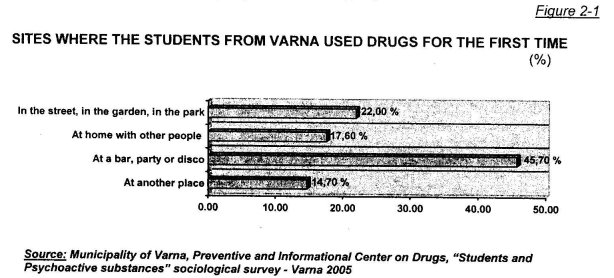
A similar tendency can be seen from the data of a survey conducted among the students in the town of Varna in 2006 this time in respect to the most common place to use synthetic drugs in the last 30 days. Usually this happened at a disco or at a party. (see Figure 2-1).
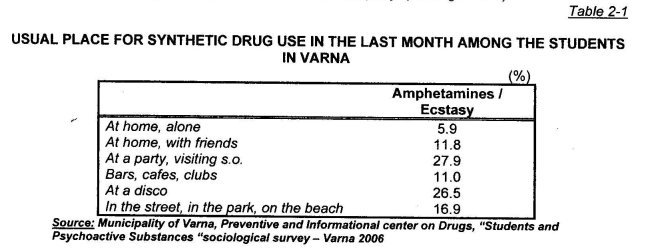
Additionally we have to mention that according to the same survey among the students in Varna marijuana was most often used when with friends in the street, in the park, on the beach, at home or at a party.
Characteristics of Drug Users
On the data from a representative survey among the general population in Bulgaria" the summarized profile of the people who have at least once used drugs in their life can be represented in the following way:
• They are more often men than women; (7.8 % from the men and 2.5 % from the women)
• Almost invariably young;
(12.5 % of the persons aged 18-29, 3.9 % of the persons aged 30-39 and 1.0 % over 39 years of age)
• More often well-off'
(13.9 % of the persons who say they are not destitute, 4.1 % of those who say they are to some extent destitute and 2.4 % of those who are severely destitute)
• More often living in the big towns than in the small ones and in the villages. (6.7 % of the population of the big towns; 3.0 % of the population of small towns / villages)
There are reasons to believe that the family status, the education completed and the ethnic belonging do not significantly affect the summarized profile of the people who have used drugs at some time in their life.18
On the data from the survey among the students in Varna 19 some of the social and demographic characteristics of the persons who have at least once in their lifetimes used some of the following substances: heroin, methadone, other opioids, cocaine, amphetamines, ecstasy, "pico", marijuana, hashish, inhalants (glues, bronze, etc.) anabolic steroids and LSD, are:
• 2/3 are under 21 years;
• 40 % live in rented accommodations or at boarding houses and the rest own their homes or live in their parents' home;
• Nearly 40 % were under 18 when for the first time they used some kind of illicit drug; 'fr As a rule this group are not married;
• 1/2 of them report having people in their circle who are known to use drugs;
• More than half of them have been to parties in the last year where drugs were used and for every fourth person of this group this was a frequent experience;
• Around 40 % have been in the last year to a disco where they saw drugs being used and every sixth of them reports that this was a frequent phenomenon;
• Nearly 2/3 report that they have been personally being offered drugs and on rare "Occasions this was forced.
The data from the survey among the students in Varna 20 also add to the portrait of the people who at least once in their life have used drugs:
• The mean age of the people using drugs for the first time is 13.9 years;
• Single-parent families are twice as many in the group of the people who have at least once in their life used drugs than in the group of the people who have never used rugs.
Drug use among specific groups of the population
Enlisted Men
On the data of the yearly analyses of the enlisted men treated at the health establishments and on the reports from the military establishments of the Bulgarian Army for the period 2001 — 2006 the following cases of drug and/or alcohol abuse among the military men were registered (see Figure 2-2):
2001 - 188 military men, of them 13 on regular service and 175 enlisted men;
2002 - 74 military men, of them 4 on regular service and 70 enlisted men;
2003 -50 military men, of them 10 on regular service and 40 enlisted men; ). 2004 - 84 military men, of them 11 on regular service and 73 enlisted men;
2005 - 23 registered cases of drug use in the military establishments of the Bulgarian Army, two of the drug users were enlisted men;
2006 - 20 registered cases of drug use in the military establishments of the Bulgarian Army, 3 of the drug users were military men.
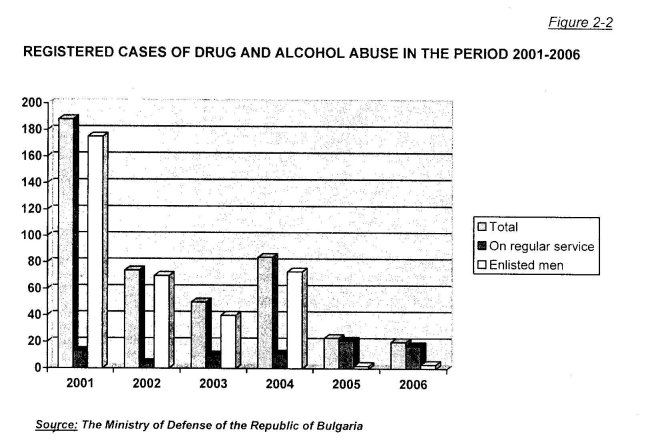
In the first 6 months of 2007 there were 35 military men who used, kept or trafficked drugs and opioid substances. Of them 17 were enlisted men, 10 were on a regular service and 8 were cadets at the higher military schools. Preliminary proceedings are being solicited for 5 cases of keeping drugs. 11 military men had disciplinary penalties imposed, and for 8 of the cases there have been investigations on the claimant's petitions, and 7 of them have been concluded with the opinion of dismissal of the military preliminary proceedings pursuant to Art. 24, Parai, itemi from the Penal Code, and the claim file of one of the cases has been delivered to other competent bodies. The files for 9 military men have been delivered to the Prosecutor's Office with a chargesheet. There are no civil persons registered- neither as addicted persons, nor as dealers.
All the military men who are drug users have undergone a course of treatment at the Clinic of Psychiatry at the Military Medical Academy and have been presented to the Central Military Medical Committee for making a decision.
While drug abuse over the period 2001-2003 was mainly among enlisted men with heroin, for the last two years the trend was to use the so called soft drugs and mainly among the men on regular service. All the registered persons had begun using drugs prior enrolling in the army.
For the Bulgarian army the drug abusers registered are within the frames of 0.05% - 0.4 %, while among the population the respective rate for this age group is much higher. For the last two years there was a several fold reduction of the cases of drug use.
In all the cases the appropriate administrative measures have been applied according to the effective regulating normative documents. 7 military men for whom drug use was registered were dismissed and 3 persons were brought to the investigating authorities. 21
Persons Deprived of Freedom
In the period May- June 2006 a representative national survey was conducted on drug use and use of other psychoactive substances among the persons in the places of confinement in Bulgaria. It included 13 places of confinement in Bulgaria out of which 26 got into the excerpt In the inquiry survey were included a total of 1409 persons deprived of freedom, of whom 1257 prisoners and 152 detainees. The survey was designed and conducted jointly with the National Focal Point on Drugs and Drug Addictions and the Penalties Enforcement Chief Directorate at the Ministry of Justice. It was funded through the National Strategy to Combat Drugs 2003-2008.
Among the Persons Deprived of Freedom (n = 1409)
A little less than 2/5 (38,5 %) of those deprived of freedom have sometimes in their lifetimes used drugs. The most often used substances are marijuana and heroin. The data show that nearly 1/3 of the persons have sometimes used marijuana, around 1/4 have used heroin and more than 1/5 have tried cocaine (see Table 2-2). A very small part of the prisoners have restricted themselves to only once using whichever of the drugs. In most of the cases the use continued, especially of marijuana, heroin, cocaine, hashish, and amphetamines. 22
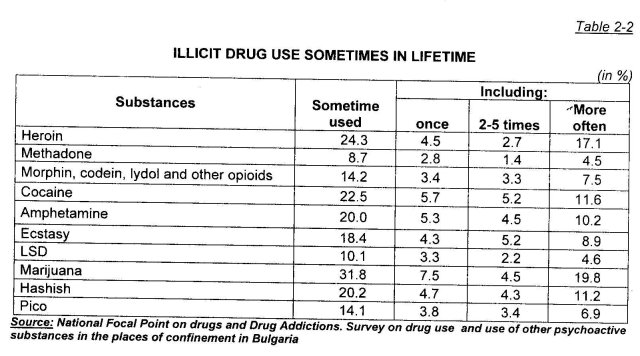
The part of the persons deprived of freedom who have used drugs over the past year reaches 16-17 °A), and in most of the cases it has been a repeated use. The prisoners who have used some drug over the past year only once are under 2,5%, and in most of the cases these were amphetamines or heroin.
The part of the prisoners who have used some drug over the past 30 days is 10.5%. The repeated use in the frames of the past month is limited to a maximum of 2.4% of the prisoners. Marijuana, heroin and ecstasy are the most often used by the prisoners (see Table 2-3)

We can say that heroin is more often used by people of elementary education, and in most of the cases it has been a repeated use (more than 5 times within the frames of a month). Among the persons of secondary and higher education the use of ecstasy and marijuana prevails, and in most of the cases the use has been repeated within the frames of the past month.
The biggest is the part of the prisoners who have begun using drugs by smoking marijuana (21.6%). Next as a first use comes heroin (7.2%). Under 3% are the prisoners who have first used cocaine.
Among the prisoners (n = 1257)
More than 1/3 (37.1 %) of the prisoners in Bulgaria have used drugs at least once in their lifetimes. This makes three fold the number of drug users among the general population of the same gender and age (see Table 2-4 and the Standard Table 12 from 2006- Drug Use among the Prisoners). Like the results from the survey among the general population, the students and the youths, among the prisoners the most widely tried drug in lifetime is marijuana. Nearly 1/3 (31.0 °/0) of them have made at least one such try, which is again thrice as many compared to the reference group from the general population. Heroin comes second according to the number of those prisoners who have used it- nearly 1/4 (23.1 %) have used it at least once in lifetime. More than 1/5 (21.9 %) have tried cocaine. It is indicative that with the exception of cannabis the use of other illicit drugs sometime in lifetime is from 6 to more than 10 times more frequently registered among the prisoners than among the general population.23 Moreover, according to the data, a relatively small part of the prisoners have restricted themselves to only once using the drug, whichever it was.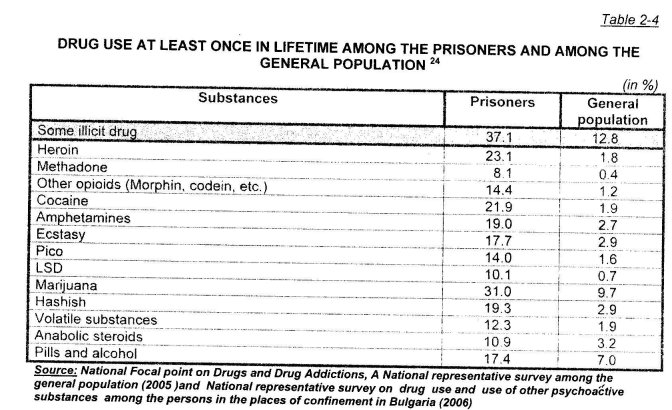
From a different perspective the same data show clearly the different structure of drug use among the two groups of the population which are compared (see Figure 2-3). While among the general population there is definitely a monopoly noticed of the use of cannabis, and the use of other substances is much less frequent (this mostly applies to stimulants), among the population of prisoners the differences among the main substances are not so significant, and the list of drugs used is considerably more various.
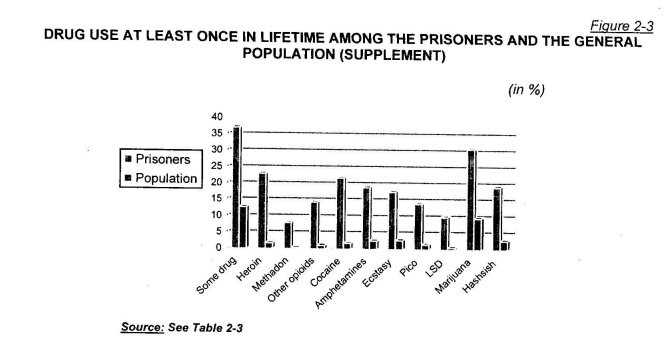
Approximately every tenth prisoner (9.4 %) has used some kind of illicit drug at least once over the last 30 days before the survey (see Table 2-5). Half of those persons have smoked marijuana (4,8 %), but of greater interest is the fact that those who have used ecstasy are even slightly more numerous (5.0 °/0). This shows that among the prisoners the modern stimulant is not less often used topical substance than cannabis, which is used on a mass scale. In most of the cases it is most probably a parallel consumption of two drugs. It is also of interest that probably around 300 prisoners (2.8 % of the sample) at the prisoners in the country have used heroin over the last month. This is not an impressive number, but it could give an idea about the need of medical assistance at the places of confinement in Bulgaria.
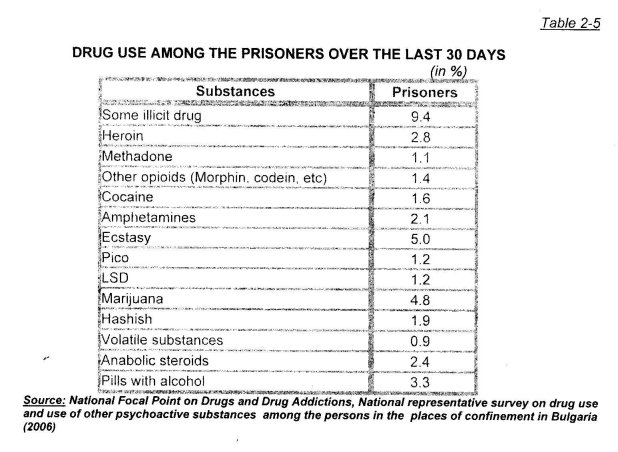
The further detailed processing of the data from the survey presents the option of giving a sort of a profile of the prisoners' population in respect to drug use. The following categories of persons are included (see also Figure 2-4):
• Without any experience in drug use (at least without such information) = 6,900
• Limited experience in drug use (once or incidentally) = 4,000
Frequent drug use (substances which are not included in the definition of problem drug use-e.g. marijuana, hallucinogens, inhalants, etc.) = 100
Problem drug use (substances which are defined as problematic for drug use – heroin, other opioids, cocaine and other stimulants) = 400
Similar classifications could be of help when scheduling interventions for prevention, treatment and harm reduction among the persons deprived of their liberty.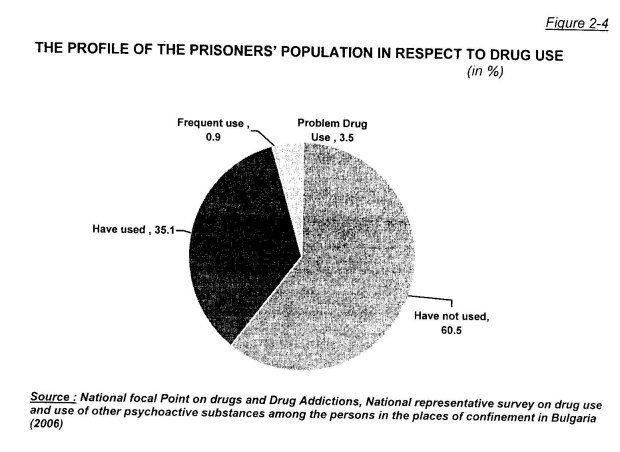
Summary
• Drug use among the persons deprived of their liberty is far more widespread than among the general population;
• Among the persons deprived of their liberty the variety of drugs used is significantly greater than among the general population including of the substances related to problem drug use;
• The ratio "used-have not used" among the persons deprived of their liberty is nearly 4 : 6, the ratio of "frequent- not very frequent use" among those who have used drugs is approximately 1 : 8, and the problem drug users represent around 4 / 5 of the persons with frequent use;
• The persons deprived of their liberty demonstrate significantly more permissive, tolerant position in relation to drug use (e.g. ecstasy and cannabis) than the general population (see the Annual report of Bulgaria 2006).
5 The national representative survey among the general population on the use of psychoactive substances, National Focal Point on Drugs and Addictions, National Center for Public Opinion Research and National Center for Social Strategies and Initiatives, February- March 2005 1037 persons aged 18-60 from 86 settlements throughout the country werepolled.
6 "University students and psychoactive substances", national representative survey among the university students in Bulgaria , National Focal Point on Drugs and Drug Addictions and Fact Marketing Agency May- June 2006, 3220 students from 24 universities in 7 Bulgarian towns have been polled
7 See Annual report on the drug-related problems in Bulgaria 2006
8 We have to bear in mind that in reality there are no big groups of "pure" drug users, who use only a definite substance; in most of the cases there is a combination of substances that are used or concomitant use of more substances.
9 Survey of psychoactive substance use among the young people aged 14 to 30 years, living in Sofia (within the frames of the "Alcohol, tobacco and drug use prevention among the young people in the countries from the Central and Eastern Europe" project) July- August 1999, National Center on Drug Addictions and Fact Marketing Agency, 1127 persons aged 14-30 years included.
10 "University students and psychoactive substances- Varna 2005", a representative sociological survey among the students in the town of Varna, Prevention Department - the Municipality of Varna, May- June 2005, 1025 students from the 3 city universities have been polled.
11 "Survey of life and the conditions of life for the young people in Europe", representative international comparative sociological research within the frames of the „European Cities against Drugs" (ECAD) project; in Sofia the survey was representative for the students from the secondary schools (9-13grade), as well as for the students born in 1990. Preventive and Informational Center on the Problems of Addictions — Sofia, November 2006, 5, 181 students have been polled from 262 classes in 99 schools in the city.
12 "Students and Psychoactive Substances — Varna 2006", representative sociological survey among the students from VIII and IX grade in the town of Varna, Prevention Department — the municipality of Vama, November 2006, 2011 students have been polled from 13 secondary schools in the town.
13 See: The public opinion of drugs and the combat against their use, MBMD and Spasenie Foundation, Analysis, March 2004; Annual reports on drugs and addictions in Bulgaria for 2004 and 2005, National Focal Point on Drugs and Drug Addictions, National Council on Drugs
14 National representative survey among the general population on the use of psychoactive substances, National Focal Point on Drugs and Drug Addictions, National Center of Public Opinion Research and the center of Social Strategies and Initiatives , February-March 2005, 1037 persons polled aged 18-60 years from 86 settlements throughout the country.
15 "University students and psychoactive substances'06", national representative survey among the university students in Bulgaria, National Focal Point on Drugs and Drug Addictions, and Fact Marketing Agency, May-June 2006, 3220 university students have oeen polled from 24 universities in 7 towns in Bulgaria.
16 See also Annual report on the drug-related problems in Bulgaria - 2006
17 National representative survey among the general population on the psychoactive substance use, National Focal point on Drugs and Drug Addictions, National Center for Public Opinion research, and Center for Social Strategies and Initiatives, February-March 2005, 1037 persons have been polled aged 18-60 from 86 settlements throughout the country.
18 See also Report on the drug-related problems in Bulgaria - 2006
19 "Students and Psychoactive Substances Varna 2005", representative sociological survey among the students in the town of Varna, Prevention Department — Municipality of Varna, May-June 2005 , 1025 university students polled from 3 universities in the town
20 "Students and Psychoactive Substances - Varna 2006", representative sociological research among the students from VIII and IX grade in the town of Varna, Prevention Department - the Municipality of Varna, November 2006 , 2011 students polled from 13 secondary schools in the town.
21 Information and data source in this section: Report of the Ministry of Defense for the Annual Report - 2007 on the state of the problems related to drug use in Bulgaria.
22 Source for this part of the report: Momchil Vassilev, Sonia Chipeva: Drug Use and Use of Other Psychoactive Substances among the Persons in the Places of Confinement in Bulgaria (Analysis of the results from a survey), National Focal Point on Drugs and Drug Addictions, Sofia, 2007, unpublished
23 Source for this part of the report Momchil Vassilev, Drug Use among the Prisoners in Bulgaria
(results from a survey), presented at the Regional Seminar on Drug Demand reduction in Southeast Europe, organized by TAIEX , 28-29 November 2007 in Sofia
24 For the purposes of the comparative analysis the data for the general population have been additionally reviewed in respect to gender and age, so that a parallel could be made about the structure of the group of prisoners, who got into the survey. In reality two "mirror in respect to basic demographic characteristics groups of respondents are compared
| < Prev | Next > |
|---|












